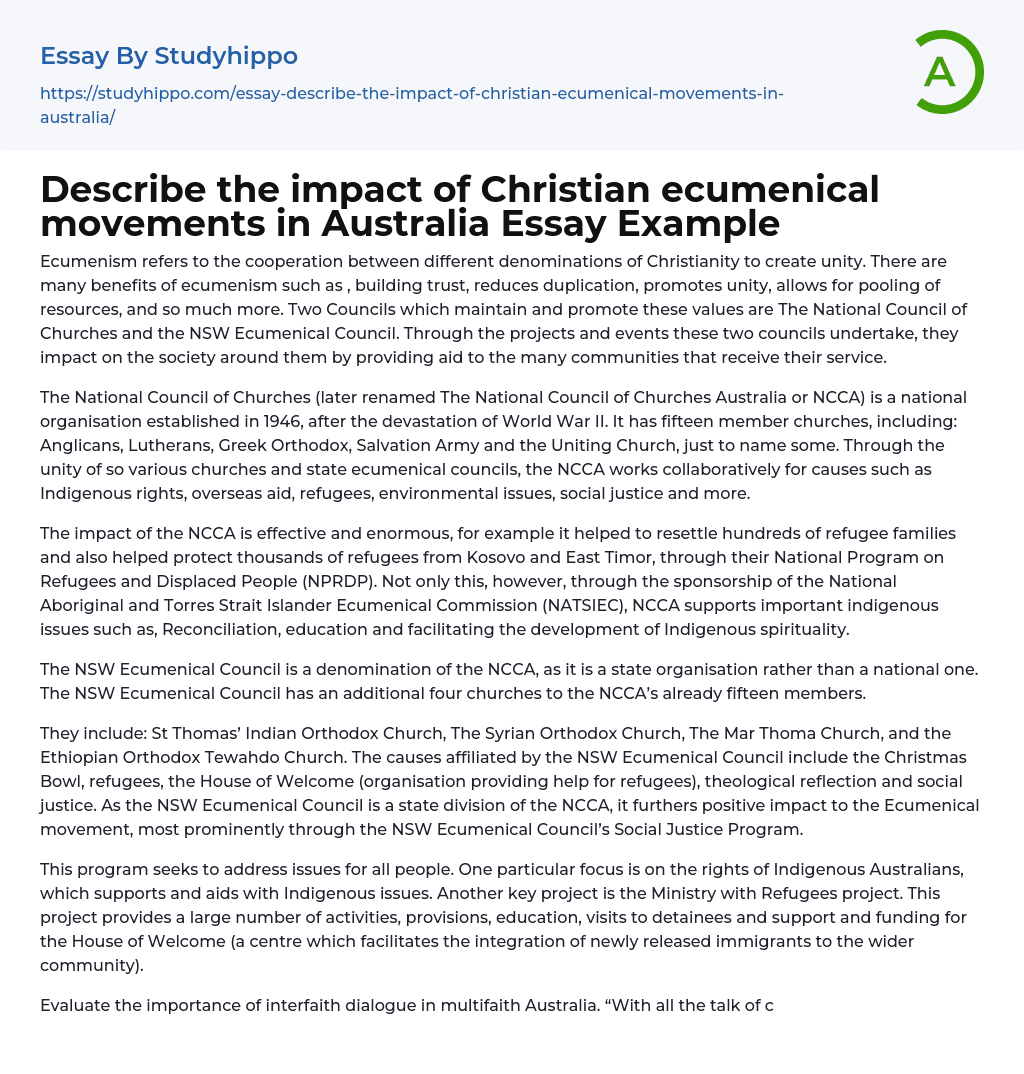

Describe the impact of Christian ecumenical movements in Australia Essay Example
Ecumenism refers to the cooperation between different denominations of Christianity to create unity. There are many benefits of ecumenism such as , building trust, reduces duplication, promotes unity, allows for pooling of resources, and so much more. Two Councils which maintain and promote these values are The National Council of Churches and the NSW Ecumenical Council. Through the projects and events these two councils undertake, they impact on the society around them by providing aid to the many communities that receive their service.
The National Council of Churches (later renamed The National Council of Churches Australia or NCCA) is a national organisation established in 1946, after the devastation of World War II. It has fifteen member churches, including: Anglicans, Lutherans, Greek Orthodox, Salvation Army and the Uniting Church, just to name some. Thro
...ugh the unity of so various churches and state ecumenical councils, the NCCA works collaboratively for causes such as Indigenous rights, overseas aid, refugees, environmental issues, social justice and more.
The impact of the NCCA is effective and enormous, for example it helped to resettle hundreds of refugee families and also helped protect thousands of refugees from Kosovo and East Timor, through their National Program on Refugees and Displaced People (NPRDP). Not only this, however, through the sponsorship of the National Aboriginal and Torres Strait Islander Ecumenical Commission (NATSIEC), NCCA supports important indigenous issues such as, Reconciliation, education and facilitating the development of Indigenous spirituality.
The NSW Ecumenical Council is a denomination of the NCCA, as it is a state organisation rather than a national one. The NSW Ecumenical Council has an additional four churches to
the NCCA’s already fifteen members.
They include: St Thomas’ Indian Orthodox Church, The Syrian Orthodox Church, The Mar Thoma Church, and the Ethiopian Orthodox Tewahdo Church. The causes affiliated by the NSW Ecumenical Council include the Christmas Bowl, refugees, the House of Welcome (organisation providing help for refugees), theological reflection and social justice. As the NSW Ecumenical Council is a state division of the NCCA, it furthers positive impact to the Ecumenical movement, most prominently through the NSW Ecumenical Council’s Social Justice Program.
This program seeks to address issues for all people. One particular focus is on the rights of Indigenous Australians, which supports and aids with Indigenous issues. Another key project is the Ministry with Refugees project. This project provides a large number of activities, provisions, education, visits to detainees and support and funding for the House of Welcome (a centre which facilitates the integration of newly released immigrants to the wider community).
Evaluate the importance of interfaith dialogue in multifaith Australia. “With all the talk of clashes of civilisations and religious differences, it is time we get together and understand each other” This is the description of interfaith dialogue given by Dr Ameer Ali, president of the Australian Federation of Islamic Councils.
Though, interfaith dialogue refers to the co-operation between people of different religious traditions, and it plays a major role in keeping harmony among the Australian society. The significance of the role of interfaith dialogue is echoed through the many affiliations and events that occur in the name of interfaith co-operation.
A prime example of this can be seen through the multifaith vigil which was held in
Strathfield Plaza, on 15th September 2001, after the terrorist attack on USA. Many religious groups attended this vigil including, Muslims, Hindus, Buddhists, Catholics, Anglicans, Korean Christian and Pentecostals, among many others.
Through this interfaith co-operation, the harmony and companionship of multifaith Australia can be seen. Another example can be seen through the ANZAC Day service of 2001 was held both by Buddhist monks and Christian ministers. This, again, shows that the harmony of the multicultural, and multifaith Australian society.
- Baptism essays
- Holy Spirit essays
- Jesus Christ essays
- Adam And Eve essays
- Crucifixion Of Jesus essays
- Crusades essays
- Eucharist essays
- God The Father essays
- Pope essays
- Protestantism essays
- Christian essays
- Church essays
- Elizabeth essays
- Sacrament essays
- Catholic Church essays
- Lord essays
- Priest essays
- Protestant Reformation essays
- Afterlife essays
- Atheism essays
- Bible essays
- Buddhism essays
- Christian Worldview essays
- Christianity essays
- Confession essays
- Cosmological Argument essays
- Deism essays
- Devil essays
- Existence of God essays
- Faith essays
- Freedom Of Religion essays
- God essays
- Hinduism essays
- Immortality essays
- Islam essays
- Jainism essays
- Jews essays
- Judaism essays
- Miracle essays
- Monk essays
- Monotheism essays
- New Testament essays
- Old Testament essays
- Pilgrimage essays
- Puritans essays
- Revelation essays
- Ritual essays
- Salvation essays
- Sin essays
- Sinners essays



